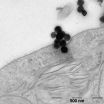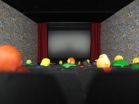(Press-News.org) Researching the safety of nanoparticles is all the rage. Thousands of scientists worldwide are conducting research on the topic, examining the question of whether titanium dioxide nanoparticles from sun creams can get through the skin and into the body, whether carbon nanotubes from electronic products are as hazardous for the lungs as asbestos used to be or whether nanoparticles in food can get into the blood via the intestinal flora, for instance. Public interest is great, research funds are flowing – and the number of scientific projects is skyrocketing: between 1980 and 2010, a total of 5,000 projects were published, followed by another 5,000 in just the last three years. However, the amount of new knowledge has only increased marginally. After all, according to Krug the majority of the projects are poorly executed and all but useless for risk assessments.
How do nanoparticles get into the body?
Artificial nanoparticles measuring between one and 100 nanometers in size can theoretically enter the body in three ways: through the skin, via the lungs and via the digestive tract. Almost every study concludes that healthy, undamaged skin is an effective protective barrier against nanoparticles. When it comes to the route through the stomach and gut, however, the research community is at odds. But upon closer inspection the value of many alarmist reports is dubious – such as when nanoparticles made of soluble substances like zinc oxide or silver are being studied. Although the particles disintegrate and the ions drifting into the body are cytotoxic, this effect has nothing to do with the topic of nanoparticles but is merely linked to the toxicity of the (dissolved) substance and the ingested dose.
Laboratory animals die in vain – drastic overdoses and other errors
Krug also discovered that some researchers maltreat their laboratory animals with absurdly high amounts of nanoparticles. Chinese scientists, for instance, fed mice five grams of titanium oxide per kilogram of body weight, without detecting any effects. By way of comparison: half the amount of kitchen salt would already have killed the animals. A sloppy job is also being made of things in the study of lung exposure to nanoparticles: inhalation experiments are expensive and complex because a defined number of particles has to be swirled around in the air. Although it is easier to place the particles directly in the animal's windpipe ("instillation"), some researchers overdo it to such an extent that the animals suffocate on the sheer mass of nanoparticles.
While others might well make do without animal testing and conduct in vitro experiments on cells, here, too, cell cultures are covered by layers of nanoparticles that are 500 nanometers thick, causing them to die from a lack of nutrients and oxygen alone – not from a real nano-effect. And even the most meticulous experiment is worthless if the particles used have not been characterized rigorously beforehand. Some researchers simply skip this preparatory work and use the particles "straight out of the box". Such experiments are irreproducible, warns Krug.
The solution: inter-laboratory tests with standard materials
Empa is thus collaborating with research groups like EPFL's Powder Technology Laboratory, with industrial partners and with Switzerland's Federal Office of Public Health (FOPH) to find a solution to the problem: on 9 October the "NanoScreen" programme, one of the "CCMX Materials Challenges", got underway, which is expected to yield a set of pre-validated methods for lab experiments over the next few years. It involves using test materials that have a closely defined particle size distribution, possess well-documented biological and chemical properties and can be altered in certain parameters – such as surface charge. "Thanks to these methods and test substances, international labs will be able to compare, verify and, if need be, improve their experiments," explains Peter Wick, Head of Empa's laboratory for Materials-Biology Interactions.
Instead of the all-too-familiar "fumbling around in the dark", this would provide an opportunity for internationally coordinated research strategies to not only clarify the potential risks of new nanoparticles in retrospect but even be able to predict them. The Swiss scientists therefore coordinate their research activities with the National Institute of Standards and Technology (NIST) in the US, the European Commission's Joint Research Center (JRC) and the Korean Institute of Standards and Science (KRISS)
INFORMATION:
Literature
Krug, H. F. (2014), Nanosafety Research — Are We on the Right Track? Angew. Chem. Int. Ed. doi: 10.1002/anie.201403367
Nanosafety research: The quest for the gold standard
Empa toxicologist criticizes poorly executed nanosafety experiments
2014-10-29
ELSE PRESS RELEASES FROM THIS DATE:
Free urban data -- what's it good for?
2014-10-29
New Rochelle, October 29, 2014 –Cities around the world are increasingly making urban data freely available to the public. But is the content or structure of these vast data sets easy to access and of value? A new study of more than 9,000 data sets from 20 cities presents encouraging results on the quality and volume of the available data and describes the challenges and benefits of analyzing and integrating these expanding data sets, as described in an article in Big Data, the highly innovative, peer-reviewed journal from Mary Ann Liebert, Inc., publishers. The Open ...
To reap the brain benefits of physical activity, just get moving!
2014-10-29
This news release is available in French. Everyone knows that exercise makes you feel more mentally alert at any age. But do you need to follow a specific training program to improve your cognitive function? Science has shown that the important thing is to just get moving. It's that simple. In fact, this was the finding of a study conducted at the Institut universitaire de gériatrie de Montréal (IUGM), an institution affiliated with Université de Montréal, by Dr. Nicolas Berryman, PhD, Exercise Physiologist, under the supervision of Dr. Louis Bherer, ...
Meiotic cell division 'the other way round'
2014-10-29
This news release is available in German. Meiosis is not like another: Gabriela Cabral and Peter Schlögelhofer at the Max F. Perutz Laboratories (MFPL) of the University of Vienna and the Medical University of Vienna dived into the process of meiosis in specific plant species and revealed that these plants display an inversion of the standard meiotic phases. The researchers describe the detailed mechanisms in the scientific journal Nature Communications.
Meiosis is the two-step series of cell divisions that make sexual reproduction and genetic diversity possible.The ...
A mechanism that allows a differentiated cell to reactivate as a stem cell revealed
2014-10-29
One kind of stem cell, those referred to as 'facultative', form part—together with other cells—of tissues and organs. There is apparently nothing that differentiates these cells from the others. However, they have a very special characteristic, namely they retain the capacity to become stem cells again. This phenomenon is something that happens in the liver, an organ that hosts cells that stimulate tissue growth, thus allowing the regeneration of the organ in the case of a transplant. Knowledge of the underlying mechanism that allows these cells to retain this ...
Cinema-like environment helps audiences immerse in movies even on small screens & displays
2014-10-29
If the surroundings are designed to be sufficiently stimulating, even a simple computer screen is enough to generate an intense cinematic experience. After observing some 300 study subjects, researchers at the Institute of Psychology of Johannes Gutenberg University Mainz (JGU) in Germany concluded that the angle of viewing does not play a vital role in the cinematic experience, thus disproving various hypotheses. According to the results of their study, the presence of so-called contextual visual cues plays a greater role in actually drawing viewers into a movie. When ...
Projecting a robot's intentions
2014-10-29
In a darkened, hangar-like space inside MIT's Building 41, a small, Roomba-like robot is trying to make up its mind.
Standing in its path is an obstacle — a human pedestrian who's pacing back and forth. To get to the other side of the room, the robot has to first determine where the pedestrian is, then choose the optimal route to avoid a close encounter.
As the robot considers its options, its "thoughts" are projected on the ground: A large pink dot appears to follow the pedestrian — a symbol of the robot's perception of the pedestrian's position in space. ...
Walking workstations improve physical and mental health, builds healthier workplace
2014-10-29
Walking workstations can improve not only physical, but also mental health during the workday, a new study released this week found. The research was conducted by faculty and student researchers from the Department of Psychology in the School of Science at Indiana University-Purdue University Indianapolis (IUPUI).
With growing concerns regarding obesity in the United States, Michael Sliter, assistant professor of psychology, hopes the study encourages employers to examine methods to assist workers in in healthy living.
"We found that the walking workstations, regardless ...
Go straight and publish: From Barcode of Life Data Systems to scholarly publishing systems
2014-10-29
An innovative workflow reveals new research potential of the Barcode of Life Data Systems (BOLD). A recently published article in the Biodiversity Data Journal (BDJ) used specimen records downloaded from BOLD in tabular format and imported these into a human-readable text developed in manuscript within the Pensoft Writting Tool (PWT). Data were used to study the species distributions of ten Nearctic species of braconid wasps from the Microgastrinae subfamily.
BOLD is originally designed to support the generation and application of DNA barcode data. However, the repository ...
Saving lots of computing capacity with a new algorithm
2014-10-29
The control of modern infrastructure such as intelligent power grids needs lots of computing capacity. Scientists of the Interdisciplinary Centre for Security, Reliability and Trust (SnT) at the University of Luxembourg have developed an algorithm that might revolutionise these processes. With their new software the SnT researchers are able to forego the use of considerable amounts of computing capacity, enabling what they call micro mining. Their achievements, which the team headed by Prof. Yves Le Traon published in the International Conference on Software Engineering ...
NYU research: Tourism as a driver of illicit drug use, HIV risk in the DR
2014-10-29
The Caribbean has the second highest global human immunodeficiency virus (HIV) prevalence in the world outside of Sub-Saharan Africa, with HIV/AIDS as leading cause of death among people aged 20–59 years within the region. Particularly hard-hit are the Dominican Republic (DR) and Haiti, on the island of Hispaniola, accounting for approximately 70% of all people living with HIV in the Caribbean region.
Insufficient attention has been paid to the intersection of drugs and tourism as contributing factors for the region's elevated HIV/AIDS risk. Caribbean studies ...
LAST 30 PRESS RELEASES:
Ticking time bomb: Some farmers report as many as 70 tick encounters over a 6-month period
Turning garden and crop waste into plastics
Scientists discover ‘platypus galaxies’ in the early universe
Seeing thyroid cancer in a new light: when AI meets label-free imaging in the operating room
Neutrophil-to-lymphocyte ratio may aid risk stratification in depressive disorder
2026 Seismological Society of America Annual Meeting
AI-powered ECG analysis offers promising path for early detection of chronic obstructive pulmonary disease, says Mount Sinai researchers
GIMM uncovers flaws in lab-grown heart cells and paves the way for improved treatments
Cracking the evolutionary code of sleep
Medications could help the aging brain cope with surgery, memory impairment
Back pain linked to worse sleep years later in men over 65, according to study
CDC urges ‘shared decision-making’ on some childhood vaccines; many unclear about what that means
New research finds that an ‘equal treatment’ approach to economic opportunity advertising can backfire
Researchers create shape-shifting, self-navigating microparticles
Science army mobilizes to map US soil microbiome
Researchers develop new tools to turn grain crops into biosensors
Do supervised consumption sites bring increased crime? Study suggests that’s a myth
New mass spec innovation could transform research
Maternal nativity, race, and ethnicity and infant mortality in the US
Migration-related trauma among asylum seekers exposed to the migrant protection protocols
Jupiter’s moon Europa has a seafloor that may be quiet and lifeless
SwRI upgrades nuclear magnetic resonance laboratory for pharmaceutical R&D
House sparrows in northern Norway can help us save other endangered animals
Crohn's & Colitis Foundation survey reveals more than 1/3 of young adults with IBD face step therapy insurance barriers
Tethered UAV autonomous knotting on environmental structures for transport
Decentralized social media platforms unlock authentic consumer feedback
American Pediatric Society announces Vanderbilt University School of Medicine as host institution for APS Howland Visiting Professor Program
Scientists discover first method to safely back up quantum information
A role for orange pigments in birds and human redheads
Pathways to net-zero greenhouse gas emissions for Southeast Asia
[Press-News.org] Nanosafety research: The quest for the gold standardEmpa toxicologist criticizes poorly executed nanosafety experiments






